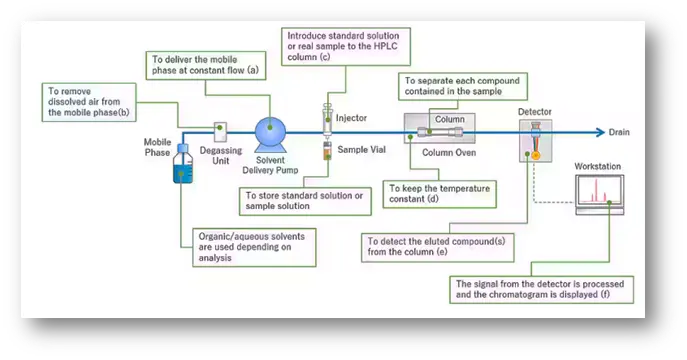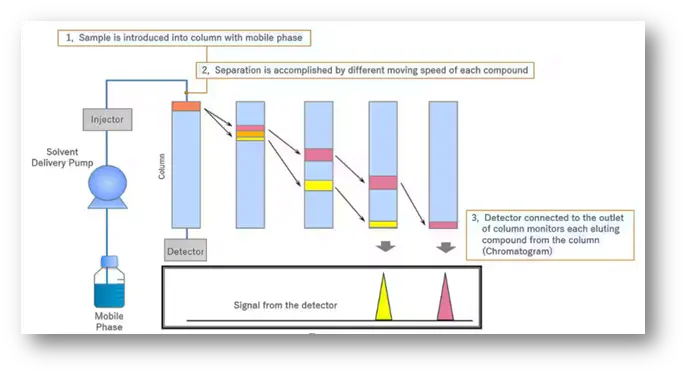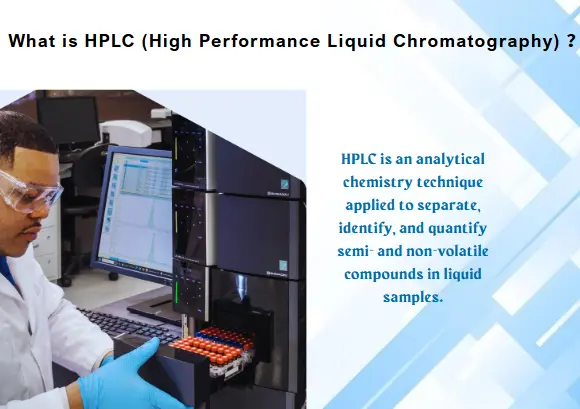What is HPLC (High Performance Liquid Chromatography) ?
HPLC is an analytical chemistry technique applied to separate, identify, and quantify semi- and non-volatile compounds in liquid samples.
High Performance Liquid Chromatography, better known as HPLC, is a powerful analytical technique used in laboratories worldwide for separating, identifying, and quantifying compounds in a liquid sample. HPLC has become a cornerstone of modern analytical chemistry, particularly in pharmaceutical, environmental, food safety, and biochemical research.
What is HPLC?
The term “HPLC” stands for High Performance Liquid Chromatography. It refers to a chromatographic technique where a mixture of compounds is separated using a liquid mobile phase under high pressure. The term “chromatography” itself means “color writing,” but in modern usage, it refers to any technique that separates components in a mixture.
HPLC differs from other chromatography methods by using high-pressure pumps and specially designed columns to achieve faster and more efficient separation. With advancements in technology, Ultra High Performance Liquid Chromatography (UHPLC) has also emerged, offering higher resolution and faster analysis.

How HPLC Works: The Basic Principle
In HPLC, only compounds dissolved in a liquid solvent can be analyzed. The main goal is to separate these compounds based on how they interact with two phases:
- Mobile Phase: The solvent that carries the sample through the column.
- Stationary Phase: The material inside the column that interacts differently with each compound in the sample.
As the mobile phase moves through the stationary phase, each compound travels at a different speed based on its affinity with either phase. This causes the components to separate and reach the detector at different times, allowing for both qualitative (what is it?) and quantitative (how much is it?) analysis.

Key Components of an HPLC System
An HPLC system consists of several interconnected modules, each playing a vital role in the analysis:
- Solvent Delivery Pump: Maintains a consistent flow of mobile phase through the system.
- Degassing Unit: Removes air bubbles from the mobile phase to prevent flow irregularities and noise in the signal.
- Sample Injector: Introduces the liquid sample into the mobile phase.
- Column Oven: Keeps the column at a constant temperature to ensure reliable separation.
- Separation Column: Contains the stationary phase that interacts with the compounds in the sample.
- Detector: Measures the compounds as they elute (exit) from the column.
- Data Processor (Workstation): Converts detector signals into a chromatogram for analysis.
Understanding HPLC Separation
The separation of compounds in HPLC occurs due to differences in how each compound interacts with the mobile and stationary phases. For example:
- A compound with high affinity for the mobile phase will pass through the column quickly.
- A compound with high affinity for the stationary phase will move slower.
This difference in elution times allows the system to distinguish and detect individual components, even from complex mixtures.

What is a Chromatogram and How Do You Read It?
A chromatogram is the graphical output of an HPLC analysis. It typically shows:
- X-axis: Time (how long each compound took to elute)
- Y-axis: Detector response (related to concentration)
Key terms in a chromatogram include:
- Baseline: The flat signal when no compounds are detected.
- Peak: A curve that appears when a compound is detected.
- Retention Time (tR): The time from sample injection to the peak apex—used for compound identification.
- Dead Time (t₀): The time it takes for a non-retained compound to travel from injector to detector.
- Peak Height & Area: Used to quantify how much of a compound is present.
Each peak corresponds to a specific compound, and its retention time and area are used for identification and concentration analysis.

Why HPLC is Crucial in Modern Science?
HPLC is essential for ensuring product quality, regulatory compliance, and scientific discovery. It is used extensively in:
- Pharmaceutical analysis: Checking drug purity and content.
- Environmental monitoring: Detecting pollutants in water and soil.
- Food testing: Analyzing additives and contaminants.
- Biotechnology: Studying proteins, peptides, and biomolecules.
Conclusion
High Performance Liquid Chromatography is a versatile, reliable, and accurate technique for analyzing chemical compounds in solution. Its ability to separate, identify, and quantify complex mixtures makes it indispensable in research, development, and quality control across multiple industries. As technology advances, HPLC continues to evolve, offering faster and more precise analytical solutions with innovations like UHPLC.
Whether you’re a student, researcher, or industry professional, understanding how HPLC works and what it reveals is key to harnessing its full potential.

